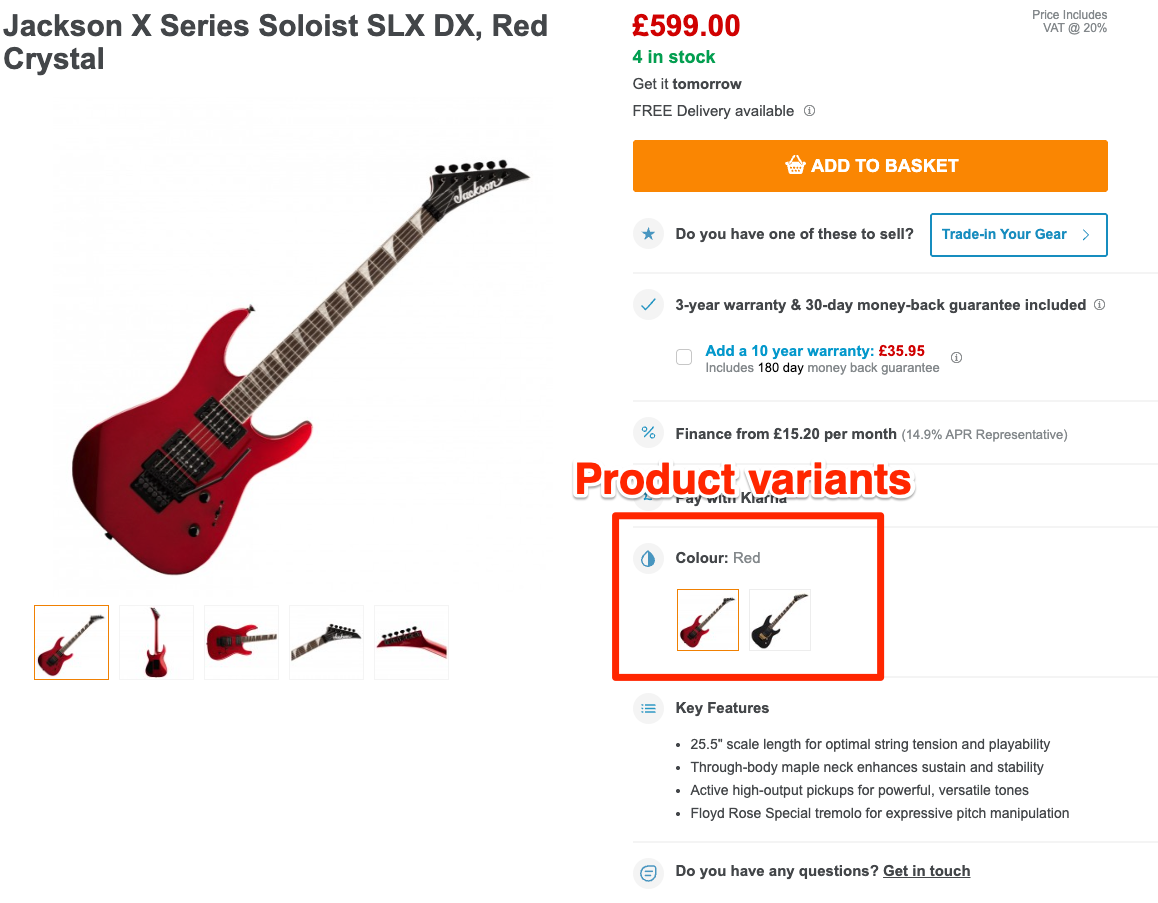If you’ve ever shopped online, you’ve probably noticed that one product can come in a bunch of different versions—like different colors, sizes, or materials.
These are called product variants, and how you handle them can make or break your online store’s success.
Let’s break down what product variants are, why they matter, and how to set up your product feed so you get the best results.
Understanding Product Variants
A product variant is just a different option for the same item. Think of a T-shirt that comes in blue, red, and green, or a phone case available in leather or silicone.
Instead of listing each option as a separate product, you group them together under one main product.
Example: I once worked with a sportswear company that listed every shoe color and size as its own product. Customers got confused, and sales didn’t improve. When they switched to showing all colors and sizes as options under one shoe listing, sales jumped by 20% in a few months. Just organizing things better made a big difference.
However, most of the time, color is the main thing that sets variants apart.

Why Good Variant Organization Matters
When you keep all the options for a product together, it’s easier for shoppers to see what’s available. People like having choices, but they also want things to be clear and simple.
What happens when variants are organized well:
- Shoppers spend more time looking at your products.
- People are more likely to find what they want and buy it.
- Bounce rates (people leaving your site quickly) go down.
Even small changes in how you show variants can help keep people interested and lead to more sales.
Problems with Bad Variant Management
If you don’t handle variants well, you can run into trouble. For example, if some sizes or colors are missing, or if you show “out of stock” for popular options, shoppers might think you don’t have what they want and leave.
Real-life example:A shoe brand I worked with didn’t offer half-sizes. Lots of customers wanted them, but couldn’t find their size, so they left without buying.
Takeaway:Missing or poorly displayed variants can cost you sales and waste your marketing efforts.
How Variants Affect Your Business
Let’s look at how product variants can change your business numbers:
1. Conversion Rate
Each variant can perform differently. Maybe a red jacket sells better in one country, while blue is more popular somewhere else. Tracking which variants sell best helps you focus your efforts.
Pro Tip: Check your data by variant, not just by product. This helps you see what’s really working.
2. Customer Engagement
Metrics like time spent on a page or number of pages viewed show if people are finding what they need. If shoppers spend more time reading than looking at pictures, you might need better images or more photos of each variant.
3. Average Order Value (AOV)
Offering premium or upgraded variants (like a leather version of a bag) can encourage shoppers to spend more. Watch which variants lead to bigger orders and use that info to plan promotions.
4. Inventory Turnover
See which variants sell out fastest. If medium black T-shirts always run out, stock more of them. This helps you avoid missing out on sales.
How to Optimize Your Product Feed
Keeping your product feed in good shape is a constant job. Here’s how to do it:
Technical Steps
- Choose the Right Format:Use the format (CSV, XML, TXT) that your marketing platform needs. Sending the wrong format can cause problems.
- Keep Data Accurate:Make sure details like color, size, and stock numbers are always up to date. Don’t advertise products you don’t have.
- Optimize Images:Use clear, fast-loading images. Show every variant, and add alt text for accessibility.
- Update Regularly:Prices and stock change all the time. Update your feed often so shoppers see what’s really available.
- Check for Errors:Run audits to catch missing info or duplicates. I’ve seen missing color data stop variants from showing up in search results.
Strategic Steps
- Unique Product IDs:Give every product and variant its own ID. Don’t reuse them. This helps search engines and platforms keep things straight.
- Use Good Keywords:Write clear titles and descriptions with keywords people actually search for. For example, “men’s maroon cotton hoodie” is better than just “hoodie.”
- Organize Categories:Group products in a way that makes sense. Separate dress shoes from sneakers, for example.
- Mobile-Friendly:Make sure your site and product feed work well on phones—fast loading, easy to tap, and clear images.
- Track Inventory:Show which variants are in stock, low, or sold out. Don’t promote items you can’t deliver.
- Show Off Visuals:Use good photos to highlight what makes each variant special.
- Test and Learn:Try different images or titles to see what gets more clicks and sales. Sometimes a new main photo can make a big difference.
Why This Matters in Ecommerce
Most online stores see conversion rates between 2% and 4%. But stores that manage product variants well can do even better.
Benefits of handling variants right:
- Customers feel like they’re getting exactly what they want.
- Your products show up in more searches.
- Shoppers are more likely to come back if they know you have what they need.
- You can manage your stock better, so you don’t run out of popular items or get stuck with slow sellers.
Product variants aren’t just extra options—they’re a key part of making your store work better for shoppers and for you. Organize them well, keep your product feed clean and up to date, and you’ll see the difference in your results.
Want to try the #1 AI Toolkit for SEO teams?
Our AI SEO assistants helps write and optimize everything - from descriptions and articles to product feeds - so they appeal to both customers and search engine algorithms. Try it now with a free trial→

![What are Product Variants and Tips for Feed Optimization [That YOU Need]](https://cdn.prod.website-files.com/689da0db4875be384646a495/689dbebe3806a25460fedee5_Sebatian.png)
![Product Disapprovals in Google Merchant Center [How to Fix Them]](https://cdn.prod.website-files.com/689da0db4875be384646a495/68a46dda8d01677982031ce4_product-disapprovals-in-merchant-center.jpg)

